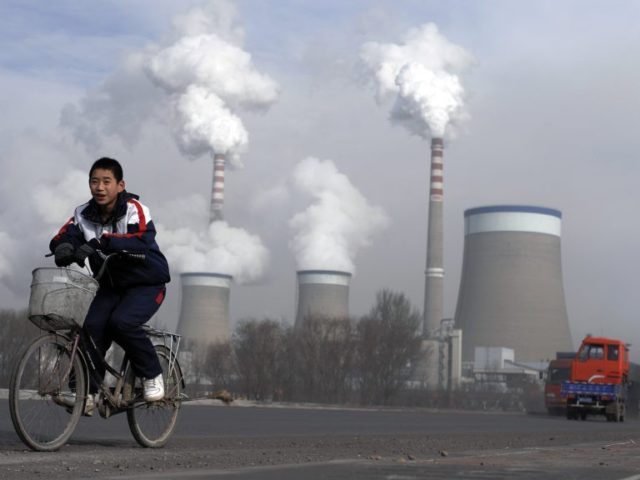The past two years have been a comprehensive disaster for the environmental movement, from the pandemic shattering Green New Deal illusions of what a “sustainable lifestyle” might look like, to polluting powerhouses like China and India burning literal mountains of coal without the slightest concern for the climate change movement.
Our pandemic carbon footprint: The economy-killing lockdowns of 2020 and 2021 dramatically reduced carbon emissions, but it still was not nearly enough to meet the demands of climate hysterics.
NASA, which is all-in on climate change theology, determined that atmospheric CO2 actually increased while carbon dioxide emissions plummeted under the lockdowns. Also, the reduction in human emissions did some strange things to the atmosphere that apparently prevented it from purging some greenhouse gasses.
In other words, the Wuhan coronavirus delivered a beyond-best-case scenario for reducing industrial activity – by far the greatest emissions decline on record as businesses were shuttered, schools closed, the roads were emptied, and people were trapped inside their homes for months – and the “benefits” from a climate change standpoint were negligible.
People will never willingly submit to such conditions again. The myth of a “green” economy that could deliver a standard of living comparable to 2019 while radically reducing energy consumption and emissions has been shattered forever.
Pandemic PPE pollution: Environmental groups are complaining that discarded masks and other personal protective equipment (PPE) are causing huge waste disposal problems.
The World Health Organization (W.H.O.) warned in February that “tens of thousands of tons of extra medical waste from the response to the COVID-19 pandemic have put tremendous strain on healthcare waste management systems around the globe.”
“The sight of discarded masks, littering pavements, beaches and roadsides, has become a universal symbol of the on-going pandemic worldwide,” W.H.O. sighed.
Not only have masks created a massive garbage problem, but W.H.O. warned discarded coronavirus test kits can generate thousands of tons of plastic and chemical waste, and those mandatory vaccination programs produced truckloads of used syringes and packaging trash. An estimated 25,000 tons of pandemic-related plastic waste ended up in the world’s oceans
Increased fossil fuel consumption: Countries like China and India have absolutely no intention of compromising their industrial goals to satisfy the Green agenda. While environmentalists work to make life poor, nasty, brutish, and short for Americans and Europeans, rising industrial powers laugh at our folly and burn record-breaking volumes of coal.
China’s coal consumption keeps hitting record highs, year after year, as it litters the developing world with carbon-spewing coal-fired power plants. The Indian government just instructed state officials to increase coal imports for years to come while it ramps up its domestic mining industry to meet surging demand.
Worldwide demand for coal and fossil fuels exploded as the pandemic lockdowns receded, pushing prices to record levels. Suppliers are pulling out all the stops to increase production of coal and natural gas. Mines and gas fields that were shut down during the pandemic came roaring back to life over the past year.
The nuclear comeback: The past two years may have finally broken one of the Green religious devotions: opposition to nuclear energy. It is increasingly difficult for them to pretend that coming anywhere near their “clean energy” goals is possible without nuclear power.
Environmentalists loathe nuclear energy as heresy against nature, but there is a real chance they will be pressured into accepting nuclear power after decades of stubborn resistance.
Among other issues, engineers are pointing out that a country the size of the United States simply cannot generate enough juice to power the growing reliance on electric vehicles demanded by environmentalists without using nuclear power.
The world’s premier purveyor of electric cars, Tesla CEO Elon Musk, agrees – and has offered to snack upon salad grown near nuclear plants to prove how safe they are.
War, what is it good for? Certainly not reduced carbon emissions. Russia’s invasion of Ukraine unleashed a full-spectrum environmental crisis – from weapons discharges and the fossil fuels burned by military vehicles, to the toxic substances released from fighting in Ukraine’s very dirty industrial sectors.
And, of course, there’s the small matter of bombs and bullets flying around Ukrainian nuclear plants and waste dumps, including the world’s most terrifying nuclear disaster site, Chernobyl. If a desperate Russia decides to make good on its blustery threats of using battlefield nukes to turn the tide in Ukraine, the environmental damage would be significant, to put it mildly.
Russia’s natural gas pipelines are a crucial factor in the Ukraine conflict. Pipelines running through Ukraine have been remarkably unaffected by the conflict so far, but that could change – and even if the pipelines are never damaged in a way that harms the environment, the conflict has made the world’s continuing dependence on natural gas painfully clear.

COMMENTS
Please let us know if you're having issues with commenting.